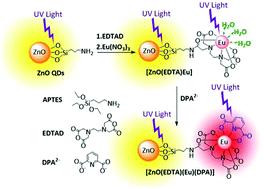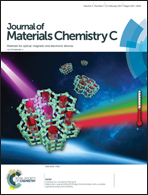Europium-decorated ZnO quantum dots as a fluorescent sensor for the detection of an anthrax biomarker
Abstract
A hybrid nanostructure based on ZnO quantum dots (QDs) has been fabricated for ratiometric detection of Bacillus anthracis spores, where yellow-emitting ZnO QDs are employed as the internal reference and europium ions (Eu3+) are chelated on the surface of the ZnO QDs as the signal report unit. The Eu3+ exhibits enhanced red luminescence upon bonding with calcium dipicolinate (CaDPA), an important biomarker of Bacillus anthracis spores, while the fluorescence of the ZnO QDs will not be altered. Accordingly, increased CaDPA levels can lead to variation of the two fluorescence intensity ratios of the ZnO/Eu hybrid nanostructure. The time-dependent fluorescence response reveals that the reaction can be completed within 8 s, thus enabling the rapid detection of Bacillus anthracis spores. The detection limit for CaDPA is 3 nM, which is six orders of magnitude lower than an infectious dosage of Bacillus anthracis spores for human beings (60 μM). In addition, the sensor shows a remarkable selectivity for CaDPA over other aromatic ligands, amino acids and common cellular ions. The fast response speed as well as good sensitivity and selectivity means the ZnO/Eu nanostructure has great potential applications in clinical analysis.



 Please wait while we load your content...
Please wait while we load your content...